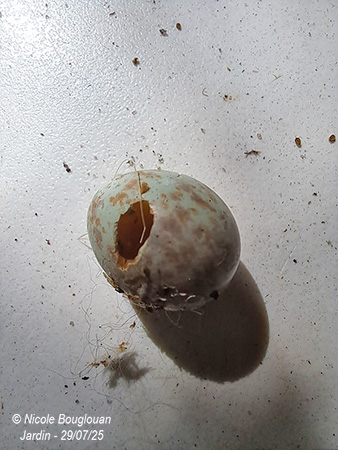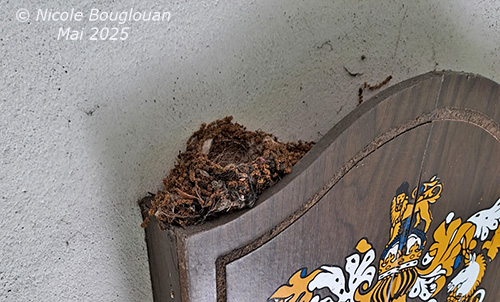
This observation was a happy episode for us at the beginning of summer. We got used to each other, and everything ultimately went very well.
This is the second time the Spotted Flycatcher has come to breed here, so maybe next year!
Text and pictures by Nicole Bouglouan
PHOTOGRAPHIC RAMBLE
The text was written by Nicole Bouglouan, following an observation in the backyard, from late August to mid-September 2020.
All the pictures and the text of this page are owned by Nicole Bouglouan.
These images and the text are subject to copyright and cannot be used without express authorization from the owner. Legal issues
Page under
copyright !
Reproduction of the Spotted Flycatcher in the garden, under our front porch
The Spotted Flycatcher, a migratory bird that spends the summer with us in southwest France (among other places), has decided this year to build its nest under our front porch.
We discovered the nest on May 27, 2025, while returning home in the late afternoon. It is built on the top, flat part of a small wooden piece of furniture located next to the front door, about two meters high. It is protected by a wooden edge that will prevent any accidental falls by little ones.

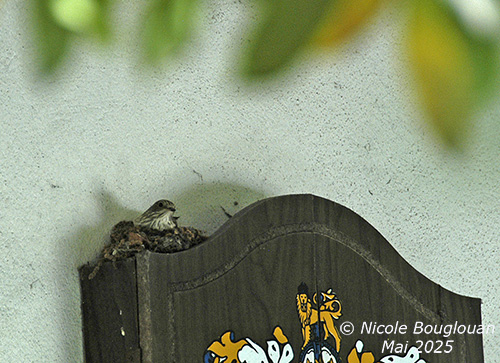
Since then, the female has occupied the nest regularly and seems to be getting used to our frequent comings and goings in this area. We are very careful, walking slowly, quietly, and without sudden movements, but it won't be easy for a whole month, the normal duration of a breeding cycle for this species.
We will nevertheless do everything possible to preserve this beautiful gift of Nature and ensure that the chicks can leave the nest on the scheduled date, normally around the end of June.
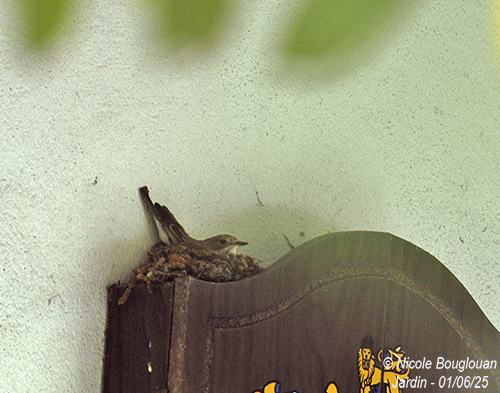
Today, on June 2nd 2025, we looked inside the nest while the female was away. We were delighted to discover four pretty green eggs with brown speckles. We didn't touch anything, of course, and the female returned two minutes later to take her place in the nest.
We left her alone during the incubation period, which lasts about 13 days.
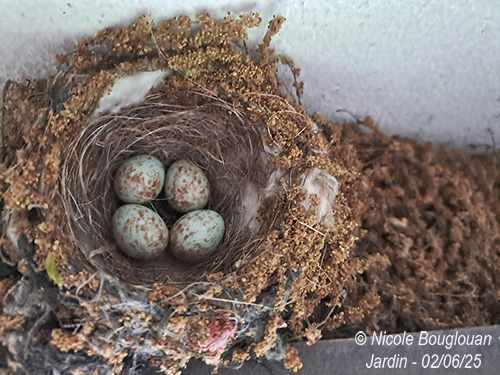
Two days ago, on June 10th, the female seemed nervous. She was pacing back and forth between the nest and the vegetation near the porch, and then returning immediately. The very stormy weather seemed to worry her, even though the nest was sheltered from the rain.
The next day, June 11th, we heard four soft little calls near the porch. Just enough time to look and we saw the male passing by unhurriedly.
For us, there was no longer any doubt, and this morning June 12th, while the female was away, I took some photos of the nest by climbing a stepladder. There, I discovered three chicks and an egg that had remained at the bottom. Will it give birth to the fourth chick or not? Time will tell.
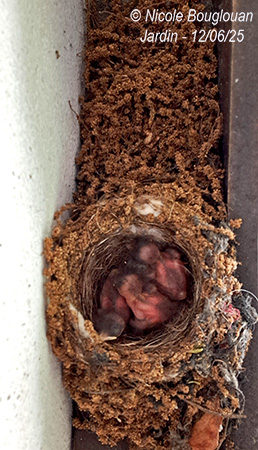
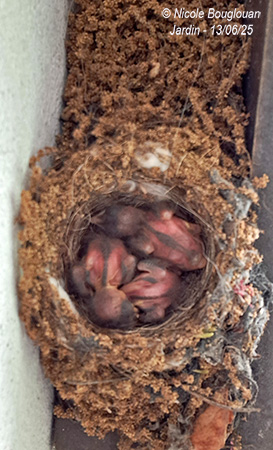
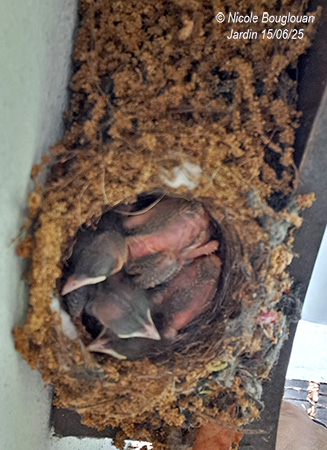
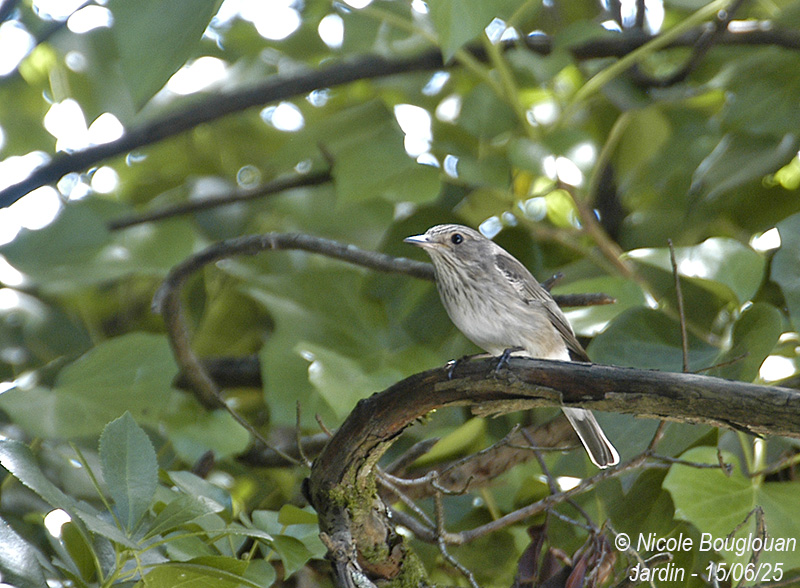
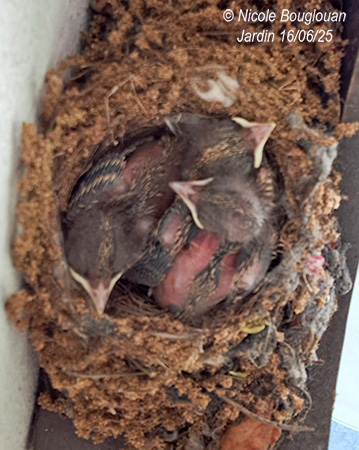
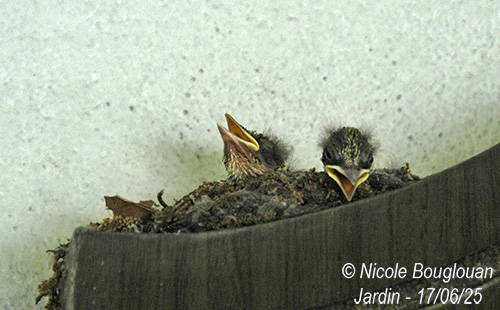
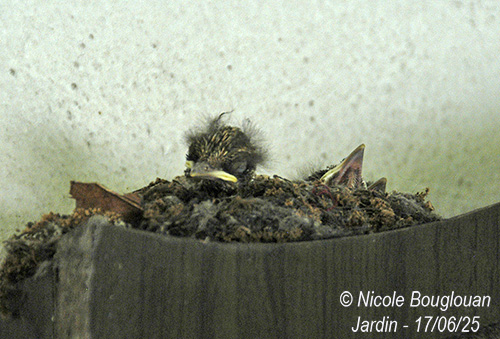
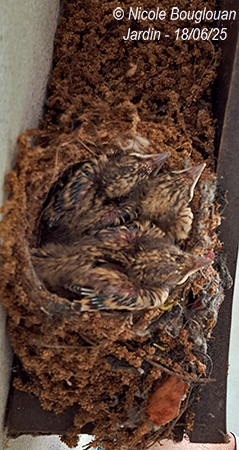
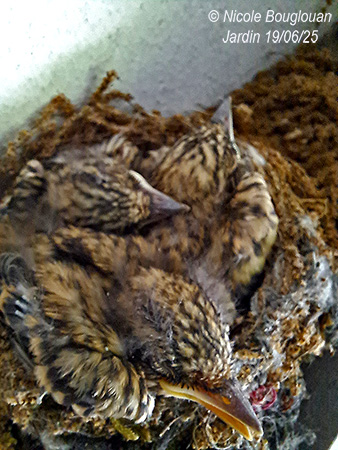
Same scene today, June 20th. The end of this episode at the nest seems to be coming to an end...
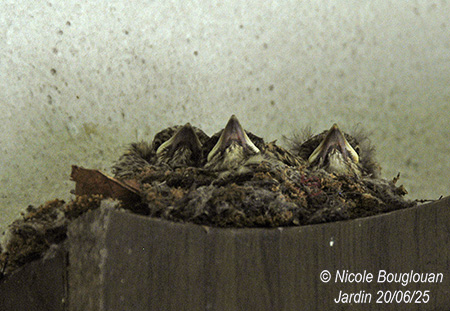
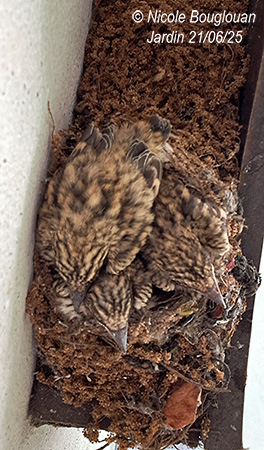
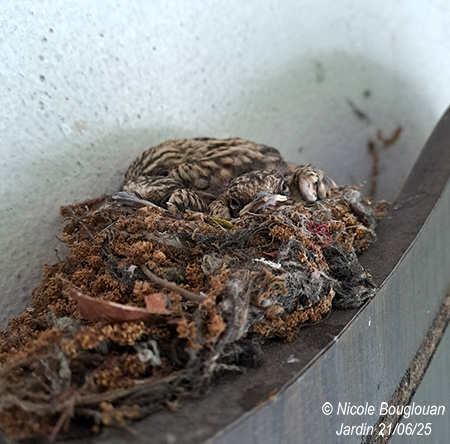
On June 22nd, the chicks were still in the nest this morning, waiting to be fed by both parents who were fluttering in the vegetation near the nest.
This afternoon, the adults seemed somewhat agitated, which could indicate an imminent departure from the nest...
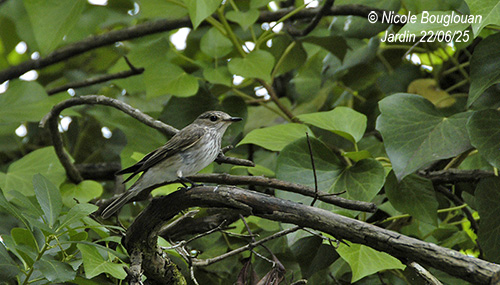
But at the end of the day, they were still there, calm and crammed into a structure that has become tiny!
And finally, judging the nest too small for three chicks, one of them went to settle right next to the nest where the female had left some remnants of vegetation.
Was this intentional???
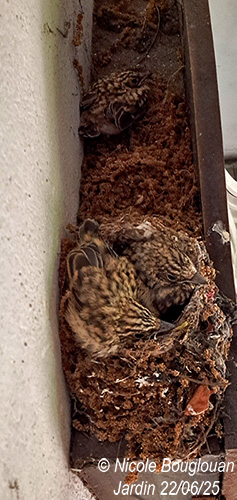
Chick outside the nest
<<<===
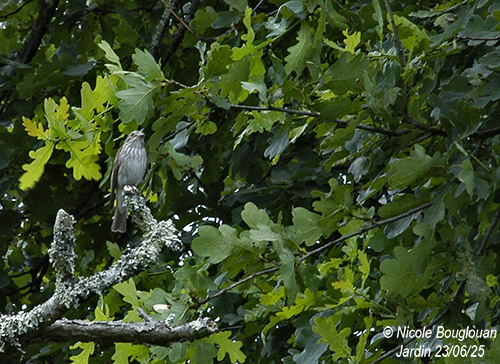
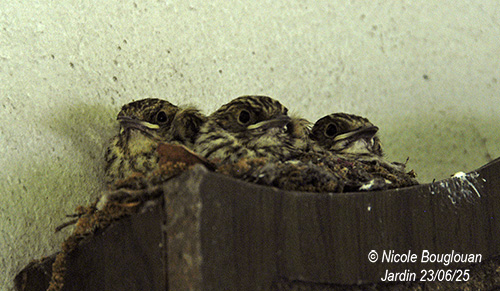
This evening around 6 p.m., the chicks were all standing facing the garden. They seemed close to fledging.
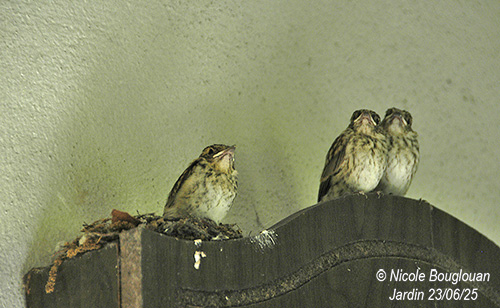
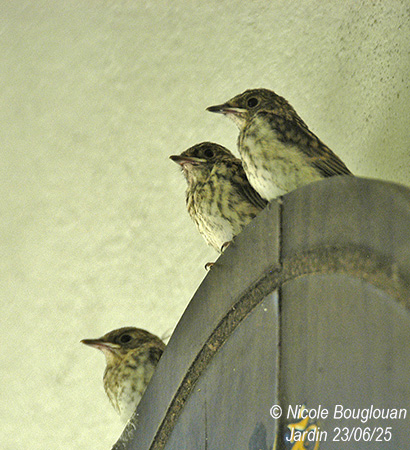
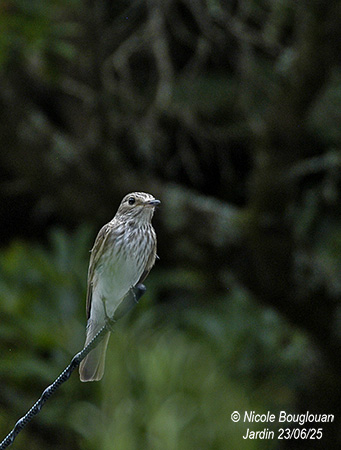
But at 8:30 p.m., two chicks were still in the nest. They will probably leave tomorrow morning, or a little later in the evening.
We're leaving them alone so as not to stress them out further!
This morning, June 24th, everyone left. All that remained was the nest with the unhatched egg.
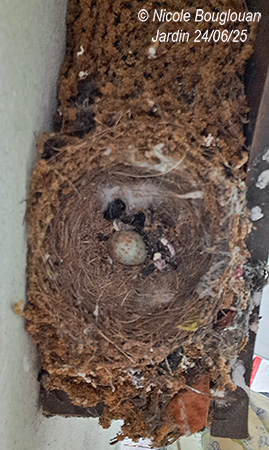
It was truly an amazing observation. The birds got used to us, but we didn't overdo it.
I was able to take photos almost every day without any problems, respecting the adults' comings and goings and the chicks' resting times.
This is the second time the Spotted Flycatcher has come to breed in our garden, but the first time, the nest was in a small tree, hidden among the climbing ivy, and only the heads of the two chicks were visible.
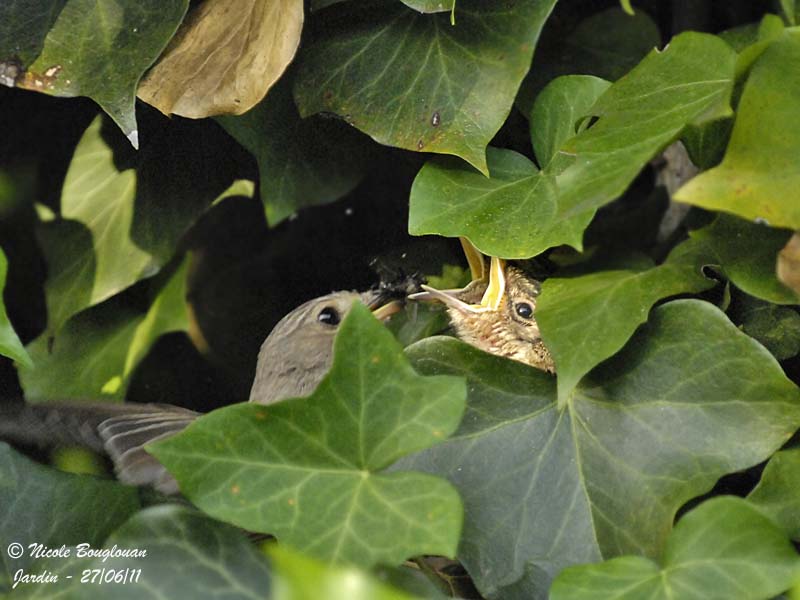
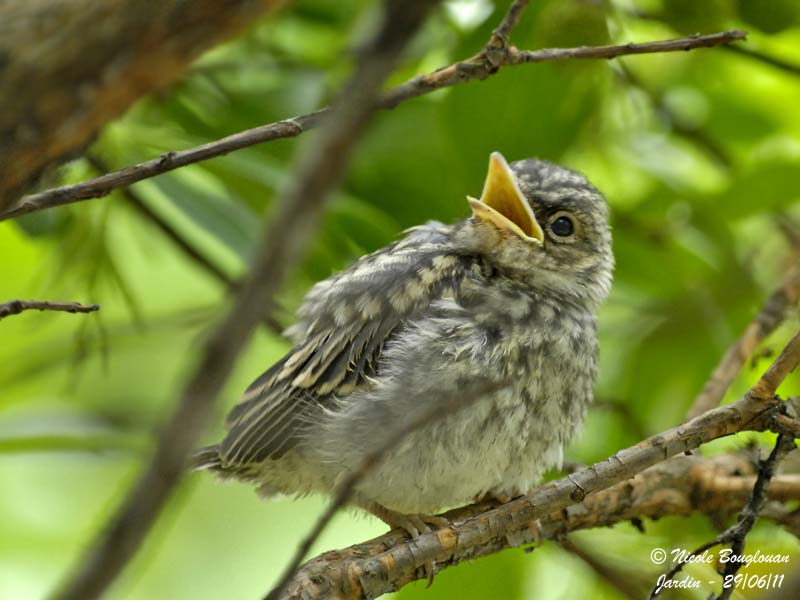
The third time's a charm! We'll see next year.
Description of the nest:
After the chicks left on June 24, 2025, we left the nest in place until July 29, just in case. But the birds didn't return to the same spot, and what's more, we didn't see them in the garden at all.
So we removed the nest from its shelf to examine it in detail.
It was built in several stages.
After some research, it appears that the plant used resembles ragweed, and more specifically, Common ragweed (Ambrosia artemisiifolia). This invasive plant, native to the Americas, was introduced to Europe starting in the late 19th century. In France, almost all departments were affected in 2019.
It doesn't seem very common in our region, but it may be found in some gardens or nearby fields. It seems clear that the birds generally collect materials not far from the nest site. The main plant element therefore seems to be the male flower (or stamen) of this plant, visible at the top of the stems.
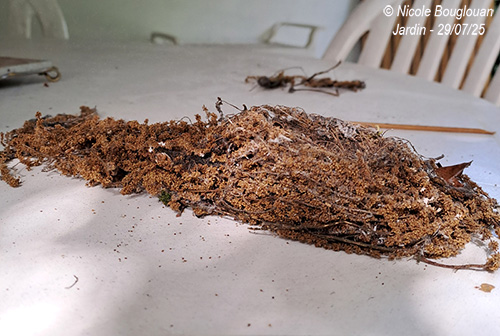
Turning the structure completely over, we see that these fine dried flowers that make up the bulk of the construction were first worked into an elongated layer 26 centimetres long. They are well braided and resist when pulled to undo them.
On this picture, we can see an oval-shaped underlayer that serves as a base for the cup itself. It is about one centimetre thick. We can also see thin stems, grasses, or plant filaments, added and interwoven with the other materials.
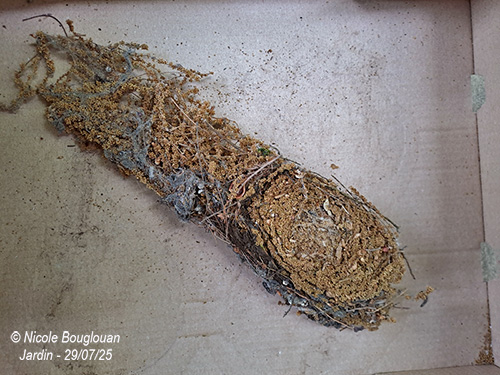
The outer part of the cup is also quite thick. It is made with the same dried flowers, woven with fine plant filaments to strengthen the whole. Inside is the cup that will hold the eggs. It is made of finer materials: thin, dry stems and long hair (probably mine!!!), to which are added a few white feathers for softness and warmth. These materials are firmly interwoven. When you touch the walls, they feel firm and solid.
This structure was ultimately modelled by the female's body, which shapes the cup by moving inside the nest several times while the materials are fresh and soft, until a truly uniformly rounded cup is achieved.
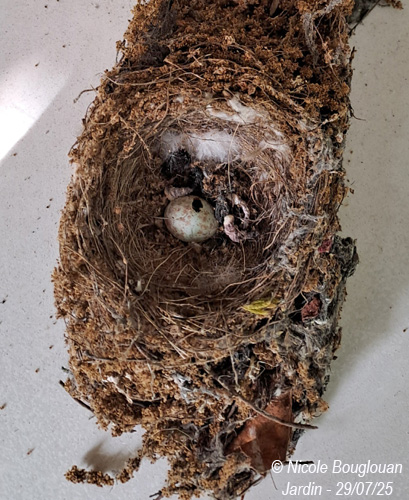
Nest dimensions inside the cup: Length: 6 cm – Width: 4 cm – Depth at centre: 3 cm
Nest dimensions outside the cup: Length: 9 cm – Width: 7 cm - Height: 4 cm
At first, the eggs are at the very bottom, but the chicks grow quickly, and the outer edges at the top of the nest stretch and sag slightly to support the chicks' heads.
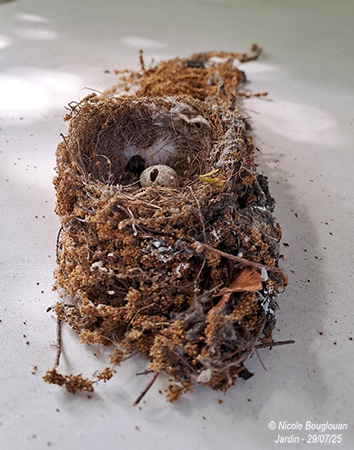
We noticed during the nesting process that the nest had become too small for the three occupants, and one evening, one of them chose to sleep outside the nest, on the part that extended to one side onto the shelf.
At that point, we wondered if this type of construction was intentional, and ultimately, we could only see its purpose.
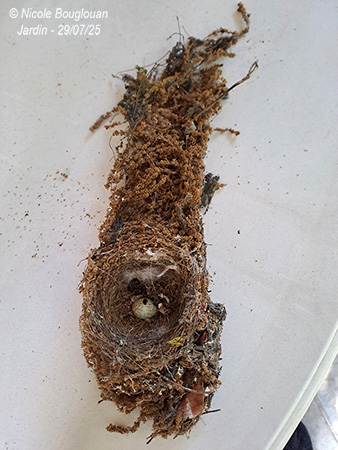
The remaining egg had a hole in it. We opened it out of curiosity, but nothing but solidified egg yolk!
